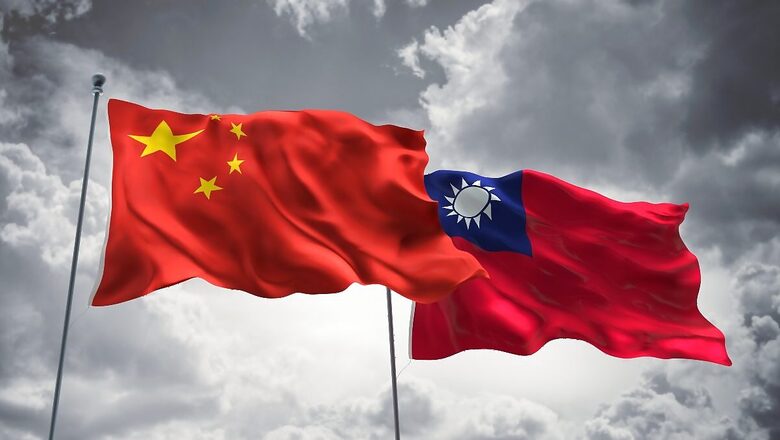
views
The China-Taiwan relationship continues to develop in a dynamic fashion, with the action-reaction cycle caused by recent events highlighting the threat to global stability. Active militarisation of the Taiwan Strait has contributed to the deteriorating security situation in the region. Over the past few months, the US has approved large-scale arms sales to Taiwan, with its most recent consignment from March 2023 comprising various anti-aircraft missiles worth $619 million. Before this, in September 2022, Taiwan purchased from the US radar systems for anti-air missiles in a consignment worth US$1.1 billion.
China, meanwhile, has continued to perform flybys beyond the Taiwan Strait median line on a daily basis, entering ROC’s Air-Defence Identification Zone (ADIZ). These flybys have grown from around 380 in 2020 to over 600 by 2021. Taiwan’s Ministry of National Defence has also reported a rapid increase in PLA aircraft and naval vessel activity around the island, and such activity has especially multiplied since the Democratic Progressive Party has come to power in Taiwan in 2016.
Increasing American engagement with the island, especially in defence and critical tech such as semiconductors, is viewed by China as a violation of its most important red lines, the ‘One China Policy’. Consequently, China retaliates against such overtures in a manner that is eroding the status quo across the Straits.
For example, during Taiwanese President Tsai Ing-Wen’s transit through the US in April, when she met with US House Speaker Kevin McCarthy, China responded in both words and action. Zhu Longjian, the spokesperson for the Chinese Taiwan Affairs Office, stated: “The so-called “transit” by the leaders of the Taiwan authorities is essentially a provocative act of “relying on the United States to seek independence”, trying to create “one China, one Taiwan” and “two Chinas”…they are looking for opportunities to sell “Taiwan independence” internationally, and seek the support of anti-China forces in the US.”
In its military response, the PLA Navy first deployed its aircraft carrier Shandong in the Bashi Channel of the Straits, as well as its Haixun 06 vessel, for a joint patrol operation. Then, between April 8 and 10, the PLA launched a combat readiness exercise titled ‘Joint Sword’ to threaten Taiwan. As part of the exercises, the PLA ground forces conducted drills pertaining to multi-target precision strikes, while the naval forces conducted live-fire drills around the island.
This aggressive posturing has led to a lot of speculation and debate about whether China will use force and by when it will be ready to launch an offensive against Taiwan. China has actively promoted peaceful means for unification until one of the three ‘ifs’ listed under Article 8 of the 2005 ‘Anti-Secession Law’ come true – “if “Taiwan independence” secessionist forces should act under any name or by any means to cause the fact of Taiwan’s secession from China;” or if “major incidents entailing Taiwan’s secession from China should occur;” or “if possibilities for a peaceful reunification should be completely exhausted.”
However, China is likely to choose peaceful over forceful unification, for two primary reasons – first is because the cost of conflict is likely to have severe consequences for China’s economic development goals, which require continued integration in global value chains and access to international capital, talent and markets. This is at the heart of Xi Jinping’s strategic goal of national rejuvenation. Secondly, evidence from public opinion statistics from Taiwan suggests that a majority of the population has an increasingly unfavourable view of the mainland, and would rather support maintenance of status quo indefinitely. In such a situation, China would be attempting to take over a population that is unwilling to accept the dissolution of its existing democratic institutions as well as its sense of identity (predominantly ‘Taiwanese’). That would be a tedious and costly affair.
In such a scenario, it becomes essential to monitor some signs that could potentially enable us to empirically theorise, if not rightly predict, when China may be preparing to invade Taiwan. This would include a study of three types of indicators – military, economic, and narrative.
Militarily, we would see amassing and deployment of China’s most important equipment for an amphibious assault and urban warfare scenario within coastal provinces like Jiangsu and Guangdong provinces, where the PLA Eastern and Southern Theatre commands are posted, four to six months prior to D-Day.
Economically, we could see the People’s Bank of China liquidating its assets from the New York Fed, the Chinese state exercising greater restrictions on the outward flow of capital from the country, and Chinese firms bringing about changes in the organisational and ownership structures in foreign operations.
Finally, we could see the mobilisation of a domestic narrative about the need for citizens to unite, prepare for revolution and reunification, and at the same time, focus on preparing for hard times, socially and economically.
The author is a Research Analyst with the Takshashila Instituion’s Indo-Pacific Studies Programme. She also co-curates a weekly Newsletter, ‘Eye on China’. Views expressed are personal.




















Comments
0 comment